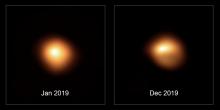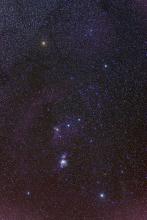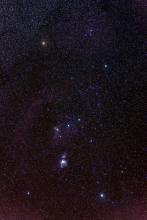Listen to today's episode of StarDate on the web the same day it airs in high-quality streaming audio without any extra ads or announcements. Choose a $8 one-month pass, or listen every day for a year for just $30.
You are here
Future Blasts
No star lasts forever. But some stars will expire more impressively than others: They’ll blast themselves to bits in titanic explosions. And several stars that are visible in April’s evening skies face that ending.
A bunch of them are in Orion, which is in the southwest at nightfall. Its belt of three stars is parallel to the horizon. Four brighter stars form a rectangle around the belt.
All seven of those stars will become supernovas. That’s because all of them are supergiants — they’re many times the mass of the Sun.
Such stars “burn” through their nuclear fuel in a hurry. They quickly reach a point where the reactions stop. When that happens, the star’s core collapses to form a neutron star or a black hole. Its outer layers fall inward, then rebound. They blast into space at up to a few percent of the speed of light. For a while, the explosion can outshine an entire galaxy of normal stars.
In Orion, the stars closest to that end probably are Betelgeuse, the bright orange light above the belt, and Rigel, a blue-white star below the belt. They could explode at just about any time. But they’ll certainly blow in the next few million years.
As Orion drops toward the horizon in early evening, another future supernova climbs skyward in the east-southeast: Spica, the leading light of Virgo. It probably has more time left than Rigel or Betelgeuse. Yet it can’t escape its fate — as an exploding star.
More about supernovas tomorrow.
Script by Damond Benningfield





